

Credit rating agency. Debt instruments the agencies rate may include government bonds, corporate bonds, CDs, municipal bonds, preferred stock, and collateralized securities, such as mortgage-backed securities and collateralized debt obligations.[3] The issuers of the obligations/securities may be companies, special purpose entities, state and local governments, non-profit organizations, or sovereign nations.[3] A credit rating permits—or facilitates—the trading of securities on a secondary market.

A credit rating affects the interest rate a security pays out, with higher ratings leading to lower interest rates. Individual consumers are not rated for credit-worthiness by credit rating agencies, but by credit bureaus (also consumer reporting agencies, credit reference agencies), which issue credit scores. The value of credit ratings for securities has been widely questioned. Big Three (credit rating agencies) The Big Three credit rating agencies are Standard & Poor's (S&P), Moody's, and Fitch Group.
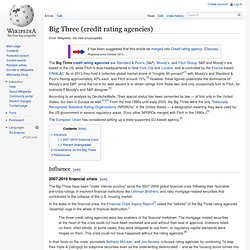
S&P and Moody's are based in the US, while Fitch is dual-headquartered in New York City and London, and is controlled by the France-based FIMALAC. As of 2013 they hold a collective global market share of "roughly 95 percent"[1] with Moody's and Standard & Poor's having approximately 40% each, and Fitch around 15%.[2] However these figures understate the dominance of Moody's and S&P, since the norm for debt issuers is to obtain ratings from these two, and only occasionally turn to Fitch, for example if Moody's and S&P disagree.[3] According to an analysis by DeutscheWelle, "their special status has been cemented by law — at first only in the United States, but then in Europe as well. Fitch Ratings - Dedicated to providing value beyond the rating. Is Fiscal Easing on the Horizon?
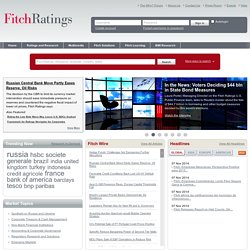
The motivations for an easing of fiscal policy in Europe are clear. Bond market conditions have been favourable, economic conditions are unfavourable and the public mood calls for short-term policy support after years of austerity. Learn more In the News: Voters Deciding $44 bln in State Bond Measures Laura Porter, Managing Director on the Fitch Ratings U.S. Moody's - credit ratings, research, tools and analysis for the global capital markets. Standard & Poor's. New York Stock Exchange. Trade On.™ CHX - Chicago Stock Exchange. NASDAQ Stock Market - Stock Quotes - Stock Exchange News - NASDAQ.com. North America and South America Stock Markets. S&P Dow Jones Indices. S&P 500. Daily Linear Chart of S&P 500 from 1950 to 2013 A logarithmic chart of the S&P 500 using closing values from January 3rd, 1950 to April 15th, 2013.
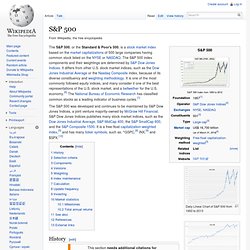
The S&P 500, or the Standard & Poor's 500, is a stock market index based on the market capitalizations of 500 large companies having common stock listed on the NYSE or NASDAQ. The S&P 500 index components and their weightings are determined by S&P Dow Jones Indices. It differs from other U.S. stock market indices, such as the Dow Jones Industrial Average or the Nasdaq Composite index, because of its diverse constituency and weighting methodology. It is one of the most commonly followed equity indices, and many consider it one of the best representations of the U.S. stock market, and a bellwether for the U.S. economy.[6] The National Bureau of Economic Research has classified common stocks as a leading indicator of business cycles.[7]
S&P 500 Index - S&P Dow Jones Indices. S&P/TSX 60. The S&P/TSX 60 Index is a stock market index of 60 large companies listed on the Toronto Stock Exchange.
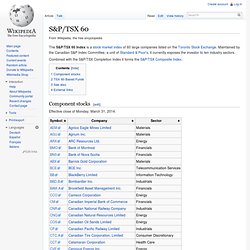
Maintained by the Canadian S&P Index Committee, a unit of Standard & Poor's, it currently exposes the investor to ten industry sectors. Combined with the S&P/TSX Completion Index it forms the S&P/TSX Composite Index. Component stocks[edit] Effective close of Monday, March 31, 2014. S&P/TSX 60 Index - S&P Dow Jones Indices. Bolsa Mexicana de Valores. BM&F Bovespa.
The BM&F BOVESPA (Portuguese pronunciation: [boˈvezpɐ]; in full, Bolsa de Valores, Mercadorias & Futuros de São Paulo) is a stock exchange located at São Paulo, Brazil.
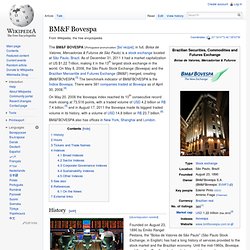
As of December 31, 2011 it had a market capitalization of US $1.22 Trillion, making it in the 13th largest stock exchange in the world. On May 8, 2008, the São Paulo Stock Exchange (Bovespa) and the Brazilian Mercantile and Futures Exchange (BM&F) merged, creating BM&FBOVESPA.[3] The benchmark indicator of BM&FBOVESPA is the Índice Bovespa. There were 381 companies traded at Bovespa as of April 30, 2008.[4] On May 20, 2008 the Ibovespa index reached its 10th consecutive record mark closing at 73,516 points, with a traded volume of USD 4.2 billion or R$ 7.4 billion,[5] and in August 17, 2011 the Ibovespa made its biggest traded volume in its history, with a volume of USD 14.8 billion or R$ 23.7 billion.[6] BM&FBOVESPA also has offices in New York, Shanghai and London.
History[edit] [disambiguation needed] Hours[edit] BM&FBOVESPA - Securities, Commodities and Futures Exchange. European Stock Markets. FTSE 100 Index. Stock Prices, Financial Markets News, FTSE 100 Index. Euronext 100. It comprises the largest and most liquid stocks traded on Euronext.
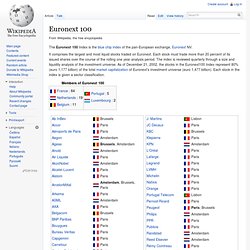
Each stock must trade more than 20 percent of its issued shares over the course of the rolling one year analysis period. The index is reviewed quarterly through a size and liquidity analysis of the investment universe. As of December 21, 2002, the stocks in the Euronext100 Index represent 80% (euro 1,177 billion) of the total market capitalization of Euronext’s investment universe (euro 1,477 billion). Each stock in the index is given a sector classification. See also[edit] External links[edit] EURONEXT 100. Skip to Content Skip to Navigation NYSE Top Hat Facebook Like Search Indices Equities Equities Directory Market Regulation Clearing Settlement.
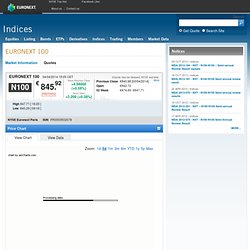
CAC 40. The CAC 40 (French: CAC quarante [kak kaʁɑ̃t]) (Cotation Assistée en Continu) is a benchmark French stock market index.
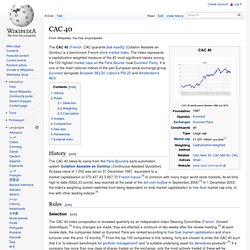
Indices. Skip to Content Skip to Navigation NYSE Top Hat Facebook Like Search Indices Equities Equities Directory Market Regulation Clearing Settlement Market Status Euronext Product Directory Market Model.

DAX. The L-DAX Index is an indicator of the German benchmark DAX index's performance after the Xetra electronic-trading system closes based on the floor trading at the Frankfurt Stock Exchange. The L-DAX Index basis is the "floor" trade (Parketthandel) at the Frankfurt stock exchange; it is computed daily between 09:00 and 17:30 Hours CET. The L-DAX index (Late DAX) is calculated from 17:30 to 20:00 CET. The Eurex, a European electronic futures and options exchange based in Zurich, Switzerland with a subsidiary in Frankfurt, Germany, offers options (ODAX) and Futures (FDAX) on the DAX from 08:00 to 22:00 CET.
The Base date for the DAX is 30 December 1987 and it was started from a base value of 1,000. DAX-Indices.com. Swiss Market Index. The SMI was introduced on 30 June 1988 at a baseline value of 1500 points. Its composition is examined once a year. Calculation takes place in real-time: as soon as a new transaction occurs in a security contained in the SMI, an updated index level is calculated and displayed. Rules[edit] Acceptance criteria[edit] To be accepted into the SMI, a given issue must meet stringent requirements with regard to liquidity and market capitalisation. 2007 restructuring[edit] The SMI comprises a fixed number of 20 securities as of the ordinary review date in September 2007. Asian Stock Markets. Dow Jones Industrial Average.